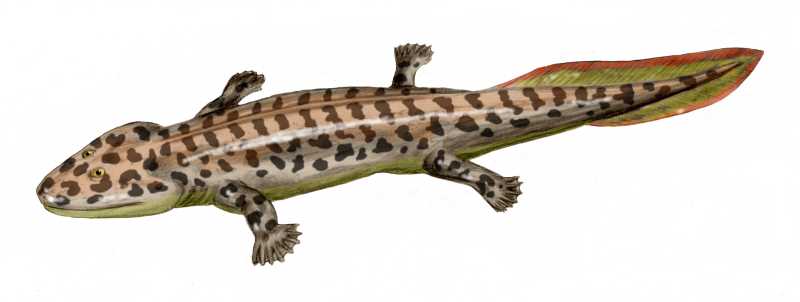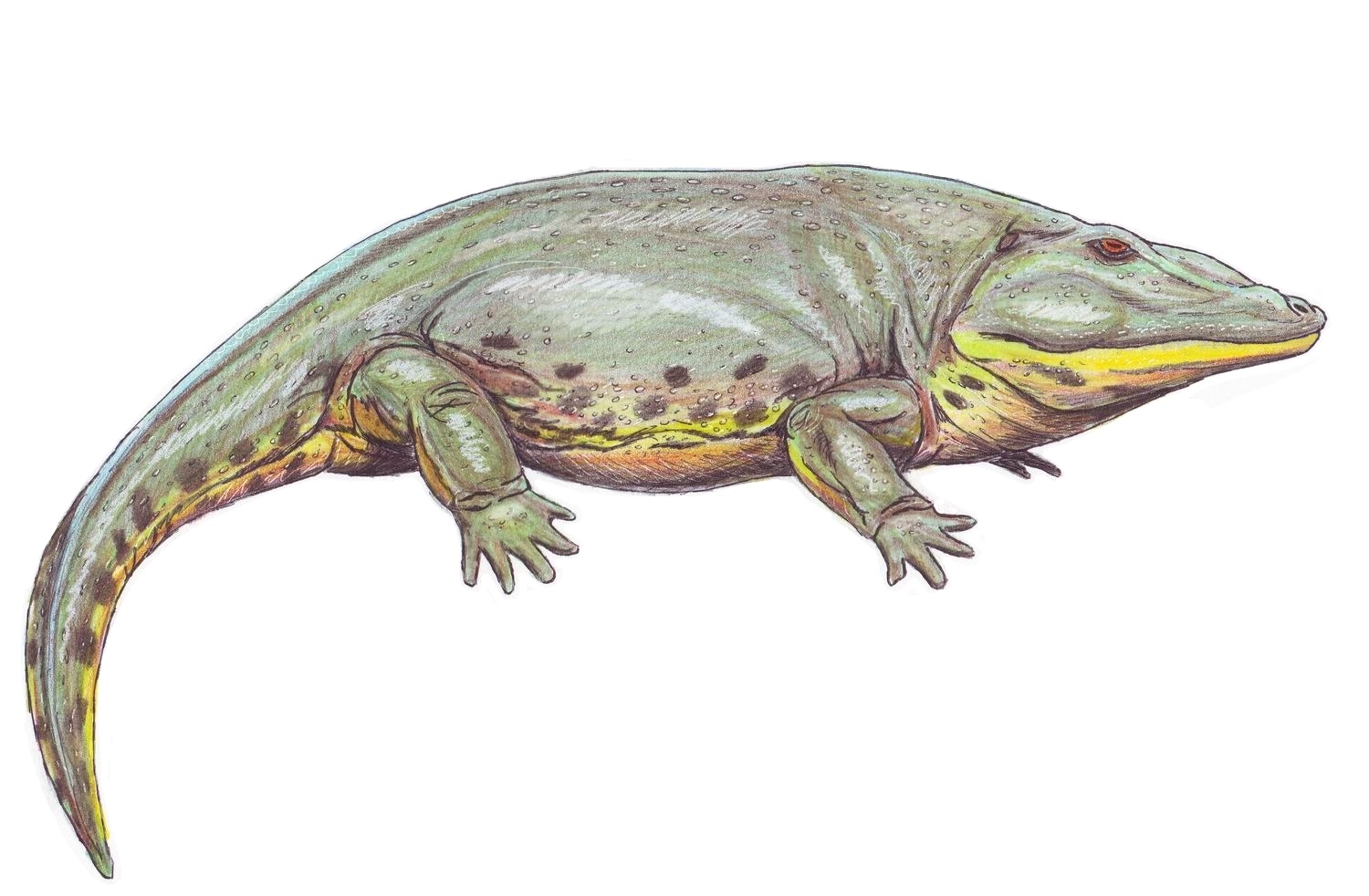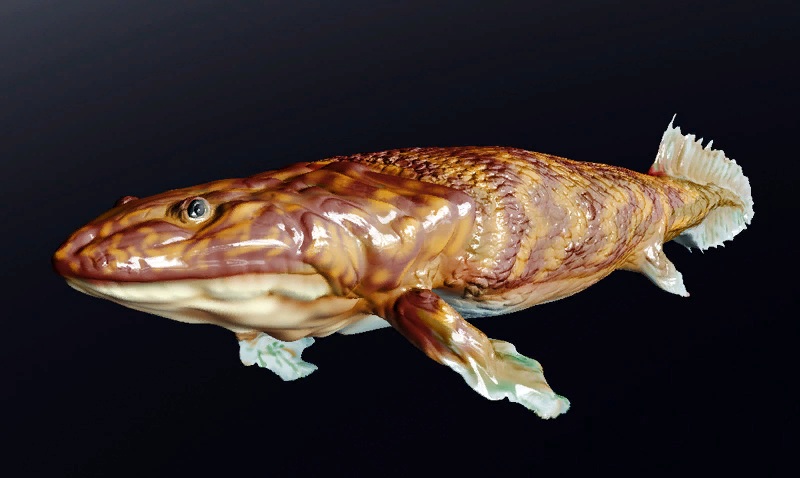|
Stegocephalians
Stegocephali (often spelled Stegocephalia) is a group containing all four-limbed vertebrates. It is equivalent to a broad definition of Tetrapoda: under this broad definition, the term "tetrapod" applies to any animal descended from the first vertebrate with limbs and toes, rather than fins. This includes both the modern lineage of limbed vertebrates (the crown group, including modern amphibians, mammals, reptiles and birds) as well as a portion of the stem group, limbed vertebrates that evolved prior to the origin of the crown group. Members of the tetrapod stem group include the earliest limbed tetrapodomorphs such as ''Ichthyostega'' and ''Acanthostega,'' which evolved in the Devonian Period long before any modern form of tetrapod. Many paleontologists prefer a stricter definition of Tetrapoda which applies solely to the crown group, excluding earlier types of limbed tetrapodomorphs. Stegocephali was re-established to replace the broad definition of Tetrapoda, resolving the us ... [...More Info...] [...Related Items...] OR: [Wikipedia] [Google] [Baidu] |
Michel Laurin
Michel Laurin is a Canadian-born French vertebrate paleontologist whose specialities include the emergence of a land-based lifestyle among vertebrates, the evolution of body size and the origin and phylogeny of lissamphibians. He has also made important contributions to the literature on phylogenetic nomenclature. As an undergraduate, he worked in the laboratory of Robert L. Carroll and earned his Ph.D. at the University of Toronto under the direction of Robert R. Reisz; his thesis concerned the osteology of seymouriamorphs. His 1991 review of diapsid phylogeny provided the broadest review of the subject up to that date. In 1995, Laurin and Reisz coauthored a widely cited article providing evidence that the synapsids are the sister group of all other amniotes. He later worked on untangling the phylogeny of the Stegocephalia, a group with a notoriously difficult phylogeny. He later moved to France; since 1998, he has been a CNRS researcher at the Muséum National d'Histoire Nature ... [...More Info...] [...Related Items...] OR: [Wikipedia] [Google] [Baidu] |
Ichthyostega
''Ichthyostega'' (from el, ἰχθῦς , 'fish' and el, στέγη , 'roof') is an extinct genus of limbed tetrapodomorphs from the Late Devonian of Greenland. It was among the earliest four-limbed vertebrates in the fossil record, and was one of the first with weight-bearing adaptations for terrestrial locomotion. ''Ichthyostega'' possessed lungs and limbs that helped it navigate through shallow water in swamps. Although ''Ichthyostega'' is often labelled a 'tetrapod' due to the possession of limbs and fingers, it evolved long before true crown group tetrapods, and could more accurately be referred to as a stegocephalian or stem tetrapod. Likewise, while undoubtedly of amphibian build and habit, it is not considered a true member of the group in the narrow sense, as the first modern amphibians (members of the group Lissamphibia) appeared in the Triassic Period. Until finds of other early stegocephalians and closely related fishes in the late 20th century, ''Ichthyostega' ... [...More Info...] [...Related Items...] OR: [Wikipedia] [Google] [Baidu] |
Tiktaalik
''Tiktaalik'' (; Inuktitut ) is a monospecific genus of extinct sarcopterygian (lobe-finned fish) from the Late Devonian Period, about 375 Mya (million years ago), having many features akin to those of tetrapods (four-legged animals). It may have grown up to in length. Unearthed in Arctic Canada, ''Tiktaalik'' is a non-tetrapod member of Osteichthyes (bony fish), complete with scales and gills – but it has a triangular, flattened head and unusual, cleaver-shaped fins. Its fins have thin ray bones for paddling like most fish, but they also have sturdy interior bones that would have allowed Tiktaalik to prop itself up in shallow water and use its limbs for support as most four-legged animals do. Those fins and other mixed characteristics mark ''Tiktaalik'' as a crucial transition fossil, a link in evolution from swimming fish to four-legged vertebrates. This and similar animals might be the common ancestors of all vertebrate terrestrial fauna: amphibians, reptiles, birds, and ... [...More Info...] [...Related Items...] OR: [Wikipedia] [Google] [Baidu] |
Acanthostega Gunnari
''Acanthostega'' (meaning "spiny roof") is an extinct genus of stem-tetrapod, among the first vertebrate animals to have recognizable limbs. It appeared in the late Devonian period (Famennian age) about 365 million years ago, and was anatomically intermediate between lobe-finned fishes and those that were fully capable of coming onto land. Description  The ''Acanthostega'' Polydactyly in stem-tetrapods, had eight digits on each ha ...
The ''Acanthostega'' Polydactyly in stem-tetrapods, had eight digits on each ha ...
[...More Info...] [...Related Items...] OR: [Wikipedia] [Google] [Baidu] |
Acanthostega
''Acanthostega'' (meaning "spiny roof") is an extinct genus of stem-tetrapod, among the first vertebrate animals to have recognizable limbs. It appeared in the late Devonian period (Famennian age) about 365 million years ago, and was anatomically intermediate between lobe-finned fishes and those that were fully capable of coming onto land. Description  The ''Acanthostega'' Polydactyly in stem-tetrapods, had eight digits on each han ...
The ''Acanthostega'' Polydactyly in stem-tetrapods, had eight digits on each han ...
[...More Info...] [...Related Items...] OR: [Wikipedia] [Google] [Baidu] |
Late Devonian
The Devonian ( ) is a geologic period and system of the Paleozoic era, spanning 60.3 million years from the end of the Silurian, million years ago (Mya), to the beginning of the Carboniferous, Mya. It is named after Devon, England, where rocks from this period were first studied. The first significant adaptive radiation of life on dry land occurred during the Devonian. Free-sporing vascular plants began to spread across dry land, forming extensive forests which covered the continents. By the middle of the Devonian, several groups of plants had evolved leaves and true roots, and by the end of the period the first seed-bearing plants appeared. The arthropod groups of myriapods, arachnids and hexapods also became well-established early in this period, after starting their expansion to land at least from the Ordovician period. Fish reached substantial diversity during this time, leading the Devonian to often be dubbed the Age of Fishes. The placoderms began dominating ... [...More Info...] [...Related Items...] OR: [Wikipedia] [Google] [Baidu] |
Eryops
''Eryops'' (; from Greek , , 'drawn-out' + , , 'face', because most of its skull was in front of its eyes) is a genus of extinct, amphibious temnospondyls. It contains the single species , the fossils of which are found mainly in early Permian (about 295 million years ago) rocks of the Texas Red Beds, located in Archer County, Texas. Fossils have also been found in late Carboniferous period rocks from New Mexico. Several complete skeletons of ''Eryops'' have been found in lower Permian rocks, but skull bones and teeth are its most common fossils. Description ''Eryops'' averaged a little over long and could grow up to , making them among the largest land animals of their time. Adults weighed between . The skull was proportionately large, being broad and flat and reaching lengths of . It had an enormous mouth with many curved teeth like the frog. Its teeth had enamel with a folded pattern, leading to its early classification as a "labyrinthodont" ("maze toothed"). The sha ... [...More Info...] [...Related Items...] OR: [Wikipedia] [Google] [Baidu] |
Phylonyms
The ''International Code of Phylogenetic Nomenclature'', known as the ''PhyloCode'' for short, is a formal set of rules governing phylogenetic nomenclature. Its current version is specifically designed to regulate the naming of clades, leaving the governance of species names up to the rank-based nomenclature codes ('' ICN'', '' ICNCP'', '' ICNP'', ''ICZN'', '' ICVCN''). The ''PhyloCode'' is associated with the International Society for Phylogenetic Nomenclature (ISPN). The companion volume, ''Phylonyms'', establishes 300 taxon names under ''PhyloCode'', serving as examples for those unfamiliar with the code. RegNum is an associated online database for registered clade names. The ''PhyloCode'' regulates phylogenetic nomenclature by providing rules for deciding which associations of names and definitions are considered established, which of those will be considered homonyms or synonyms, and which one of a set of synonyms or homonyms will be considered accepted (generally the one reg ... [...More Info...] [...Related Items...] OR: [Wikipedia] [Google] [Baidu] |
Vestigiality
Vestigiality is the retention, during the process of evolution, of genetically determined structures or attributes that have lost some or all of the ancestral function in a given species. Assessment of the vestigiality must generally rely on comparison with homologous features in related species. The emergence of vestigiality occurs by normal evolutionary processes, typically by loss of function of a feature that is no longer subject to positive selection pressures when it loses its value in a changing environment. The feature may be selected against more urgently when its function becomes definitively harmful, but if the lack of the feature provides no advantage, and its presence provides no disadvantage, the feature may not be phased out by natural selection and persist across species. Examples of vestigial structures (also called degenerate, atrophied, or rudimentary organs) are the loss of functional wings in island-dwelling birds; the human vomeronasal organ; and the hi ... [...More Info...] [...Related Items...] OR: [Wikipedia] [Google] [Baidu] |
Digit (anatomy)
A digit is one of several most distal parts of a limb, such as fingers or toes, present in many vertebrates. Names Some languages have different names for hand and foot digits (English: respectively " finger" and "toe", German: "Finger" and "Zeh", French: "doigt" and "orteil"). In other languages, e.g. Arabic, Russian, Polish, Spanish, Portuguese, Italian, Czech, Tagalog, Turkish, Bulgarian, and Persian, there are no specific one-word names for fingers and toes; these are called "digit of the hand" or "digit of the foot" instead. In Japanese, yubi (指) can mean either, depending on context. Human digits Humans normally have five digits on each extremity. Each digit is formed by several bones called phalanges, surrounded by soft tissue. Human fingers normally have a nail at the distal phalanx. The phenomenon of polydactyly occurs when extra digits are present; fewer digits than normal are also possible, for instance in ectrodactyly. Whether such a mutation can be s ... [...More Info...] [...Related Items...] OR: [Wikipedia] [Google] [Baidu] |
Panderichthys
''Panderichthys'' is a genus of extinction, extinct Sarcopterygii, sarcopterygian (lobe-finned fish) from the late Devonian period, about 380 Myr, Mya. ''Panderichthys'', which was recovered from Frasnian (early Late Devonian) deposits in Latvia, is represented by two species. ''P. stolbovi'' is known only from some snout fragments and an incomplete lower jaw. ''P. rhombolepis'' is known from several more complete specimens. Although it probably belongs to a sister group of the earliest tetrapods, ''Panderichthys'' exhibits a range of features transitional between Tristichopteridae, tristichopterid lobe-fin fishes (e.g., ''Eusthenopteron'') and early tetrapods. It is named after the German-Baltic paleontologist Christian Heinrich Pander. Possible tetrapod tracks dating back to before the appearance of ''Panderichthys'' in the fossil record were reported in 2010, which suggests that ''Panderichthys'' is not a direct ancestor of tetrapods, but nonetheless shows the traits that evolve ... [...More Info...] [...Related Items...] OR: [Wikipedia] [Google] [Baidu] |
Clade
A clade (), also known as a monophyletic group or natural group, is a group of organisms that are monophyletic – that is, composed of a common ancestor and all its lineal descendants – on a phylogenetic tree. Rather than the English term, the equivalent Latin term ''cladus'' (plural ''cladi'') is often used in taxonomical literature. The common ancestor may be an individual, a population, or a species (extinct or extant). Clades are nested, one in another, as each branch in turn splits into smaller branches. These splits reflect evolutionary history as populations diverged and evolved independently. Clades are termed monophyletic (Greek: "one clan") groups. Over the last few decades, the cladistic approach has revolutionized biological classification and revealed surprising evolutionary relationships among organisms. Increasingly, taxonomists try to avoid naming taxa that are not clades; that is, taxa that are not monophyletic. Some of the relationships between org ... [...More Info...] [...Related Items...] OR: [Wikipedia] [Google] [Baidu] |






